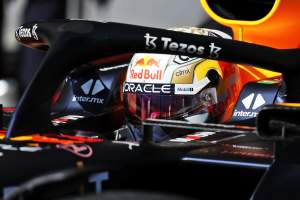Up Next

It’s been great to see how much variation there has been in sidepod design with the 2022 Formula 1 cars.
Although over time the designs are likely to converge in one direction, the big question is which direction it will be in. We might start to get an idea of that during the Bahrain test, especially if we do see a major upgrade from Mercedes.
By taking a look at the various approaches taken by different teams, we can build an understanding of what they are all trying to achieve – and perhaps who might have the right idea.
ASTON MARTIN
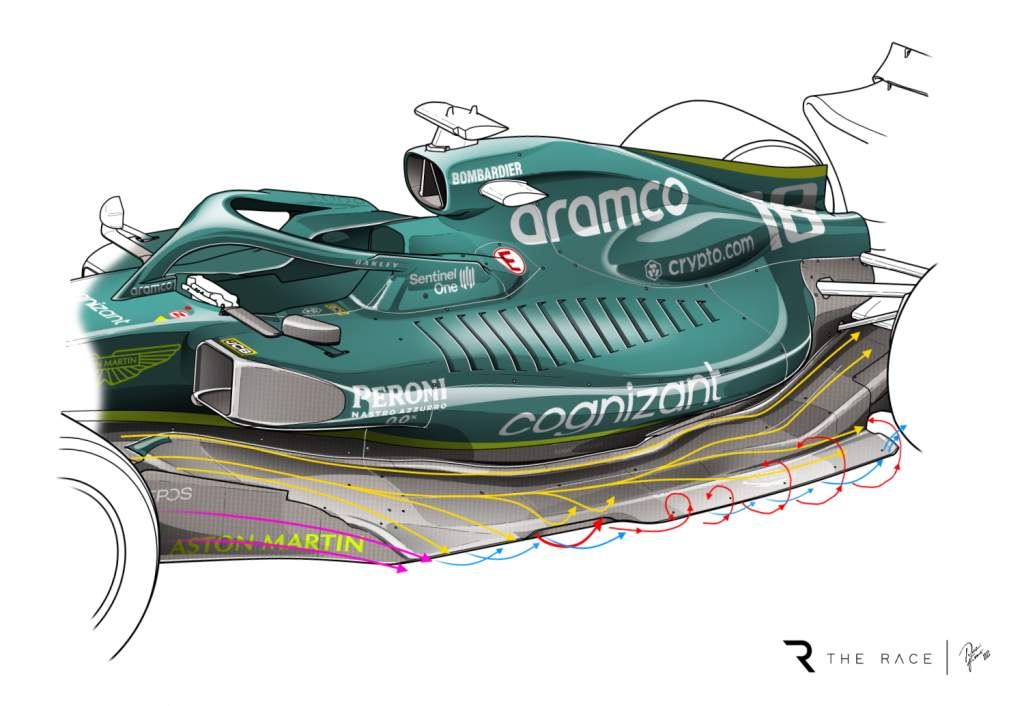
Aston Martin has gone for a fully-open sidepod undercut, running from front to back. This enables it to get the maximum airflow over the top surface of the underfloor, which should generate a larger area of pressure differential – high pressure above, low pressure below.
However, what I think we are starting to see is that the teams that manage the flow over the front corner of the floor to the maximum are getting better performance from the underfloor. They achieve this by setting up the vortices that help seal the sides of the floor as early as possible, which increases the low pressure under the car by sealing off the sides of the floor.
Aston Martin has not really used that philosophy. It doesn’t have the bluff sidepod lower surface below the radiator intake duct to turn the flow outwards. This means it is more in line with the intention of the regulation changes, but you can’t do that if it hurts performance.
It does have a small turned-up section to help extract some of the flow from the underside of the car and the upper surface of the floor design is sympathetic to any vortices that have been created in that area. But I’m just not sure that they will be strong enough to be beneficial as required.
I’m sure there are many ways to achieve the same objective and within this very tidy design on the Aston Martin there is opportunity for developments to improve the performance of the underfloor. Perhaps we will see some of them during the Bahrain test?
MERCEDES
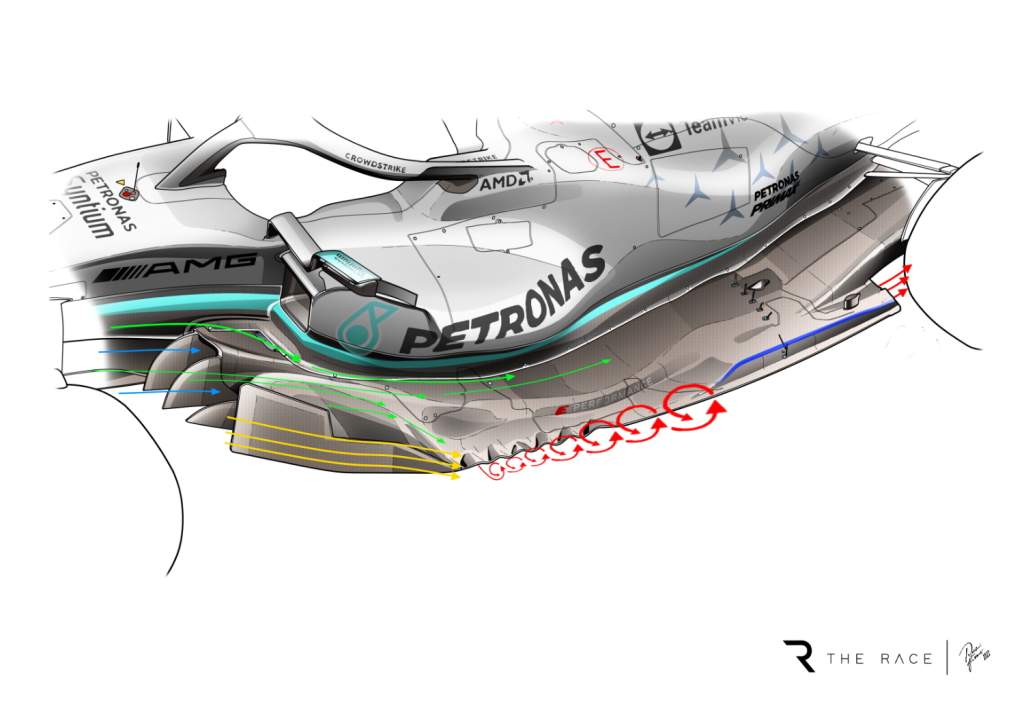
We are likely to see changes at the Bahrain test, so it will be interesting to compare what Mercedes ran in Barcelona with what we see later this week.
The illustration shows how the basic airflow works. But with most teams suffering some level of porpoising and not wanting to raise the ride height slightly or prevent it from getting so low on the straights – both of which will cost performance – it will be fairly difficult to find a cure. However, the answer could be in the design of the outer part of the underfloor.
To initiate a vortex down the side of the car, Mercedes has these small upside-down U-shaped ducts on the first part of the leading edge. These should individually set up a vortex and, if spaced correctly, they should all join up increasing the intensity of the the overall vortices.
But Mercedes has this raised section on the rear half of the floor, which is marked in blue. This will interfere with the vortex forming any further rearward.
Basically, the vortex will burst by hitting this and will therefore have very little sealing effect further rearward, which is where it is critical to the overall performance of the underfloor.
This area of floor needs to be more sympathetic to the rotation of the vortices to allow them to build. If that can be done then the underfloor should work better with the ride height slightly higher, which will reduce the porpoising effect caused by the mechanical seal when the sides of the underfloor get very close or even touch the ground.
If you use a mechanical seal, it is a bit like a light switch, either on or off. Using the vortices to achieve the same seal means it becomes more like a dimmer switch and is much more progressive.
McLAREN
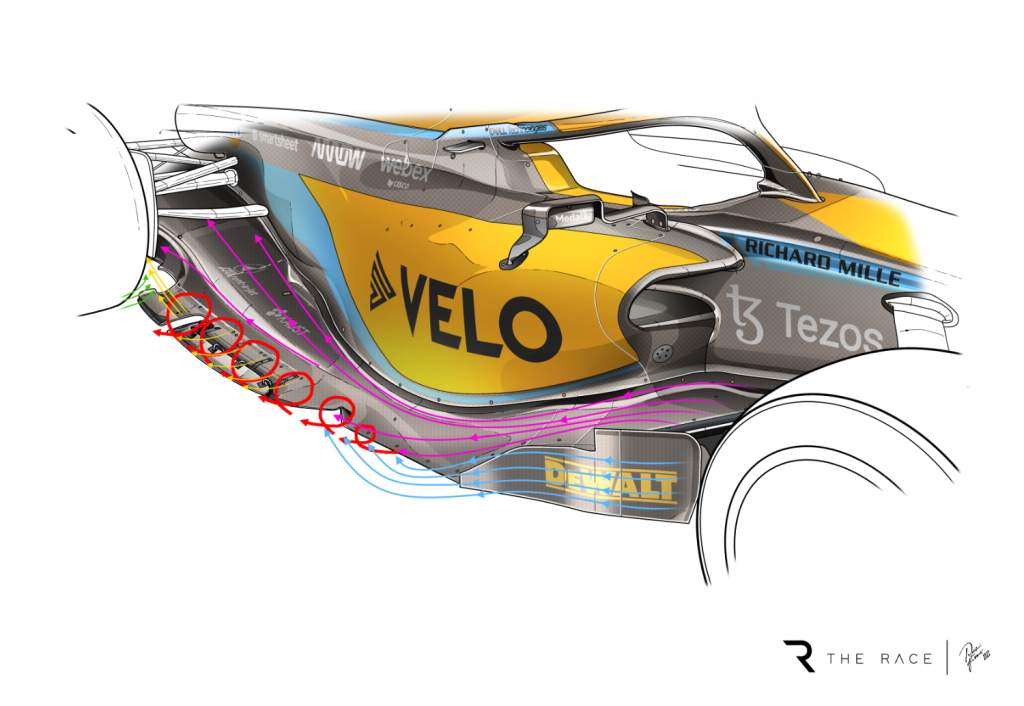
The first thing that stands out to me on the McLaren floor and sidepod area is how sympathetic the upper floor surface is to allowing vortices to build. Everything is there to help, with nothing in the way that could ‘burst’ their formation.
Once you can do that and improve your underfloor performance because of it, you are in a good place and it shows that you understand why you are going in that direction.
There are probably other cars out there that initiate the vortices in a better way but then don’t allow them room to build because their floor designs are not comparable in terms of maximising what the vortex can do for you.
If the gap from the floor to the track surface is changing, which it is constantly, you have got to allow for the flow being pulled out from underneath the car to vary and still keep the power in the vortex. To me, that is what the detail on the McLaren floor manages to achieve – so I would say it is more robust than some other designs.
All that said, I’m sure there are a few other designs that will work just as well. However, they might just be that little bit more critical to get the best out of them.
RED BULL
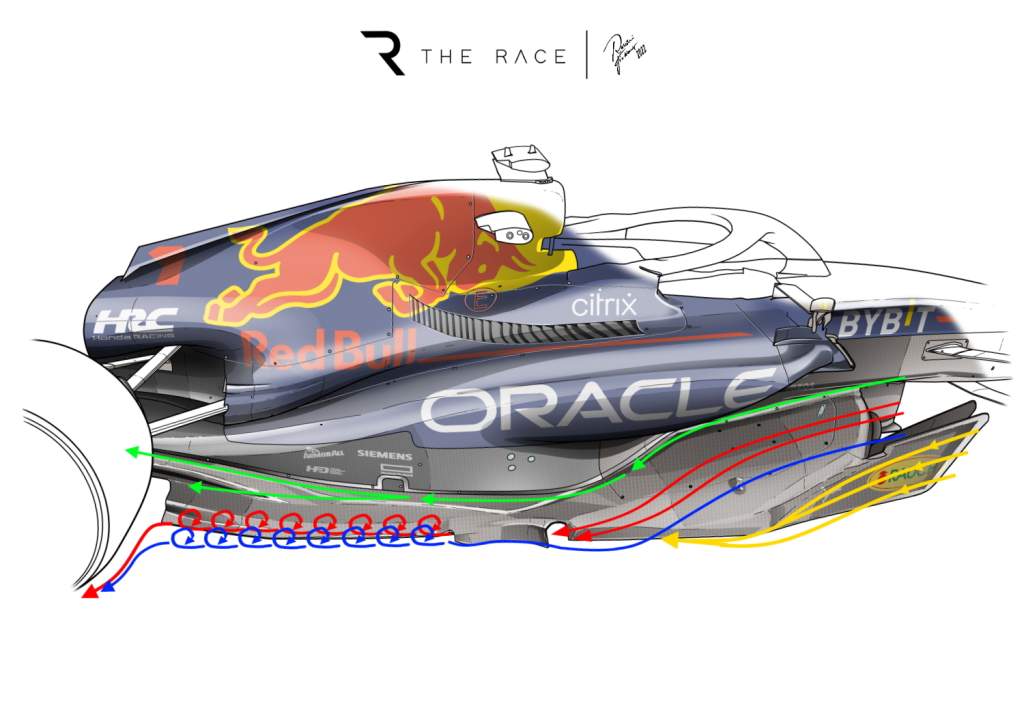
Red Bull has the most distinctive shape at the front of the sidepods but it’s just another variation of trying to achieve a similar effect.
The green arrows indicate the airflow coming over the top of the underfloor surface. This flows along the undercut of the sidepod and is fed into the gap between the diffuser’s inner wall and the rear wheel fairing.
There are some very powerful turning vanes, mounted directly on the rear wheel insider fairing, picking up that flow and turning it upwards, so generating quite a bit of suction on this area inside the wheel.
These winglets put aerodynamic load directly onto the rear-wheel assembly without it going through the suspension. That means the downforce is there immediately and consistently when the chassis is moving during braking.
The red arrows indicate the airflow coming over the top surface of the underfloor that then joins up with the airflows in blue and yellow.
Together, these set up a vortex that travels down the outer edge of the rear part of the floor. This will be rotating clockwise on this side of the car when looked at from the front.
These are crucial for sealing the underfloor, which means the underfloor will produce much higher aerodynamic load.
Red Bull also has two small cutouts to help initiate and then give room for these vortices to form.
CONCLUSION
As I’ve said above, there are many ways to achieve the same outcome. However, some will be easier to optimise than others so I’m sure we will see developments in this area in Bahrain that might just give us a clue as to the direction the teams will be heading in.
It’s never easy with new regulations to hit the ground running,but someone will and they could just have that early advantage that is vital if you are going to put in a championship bid.





